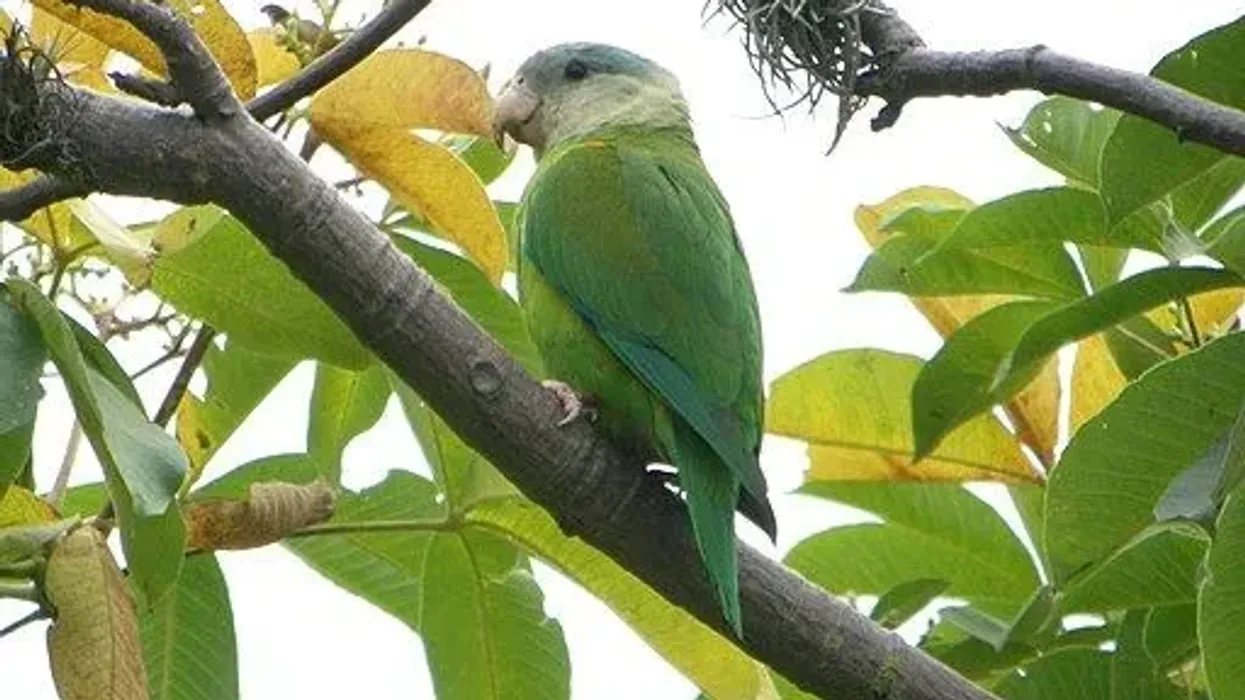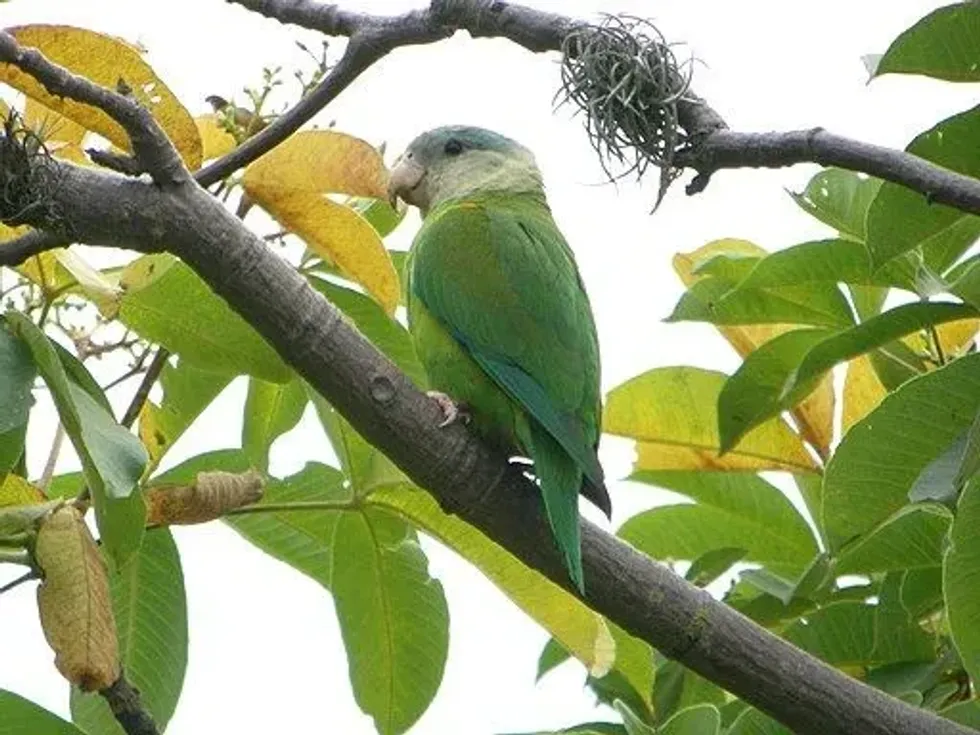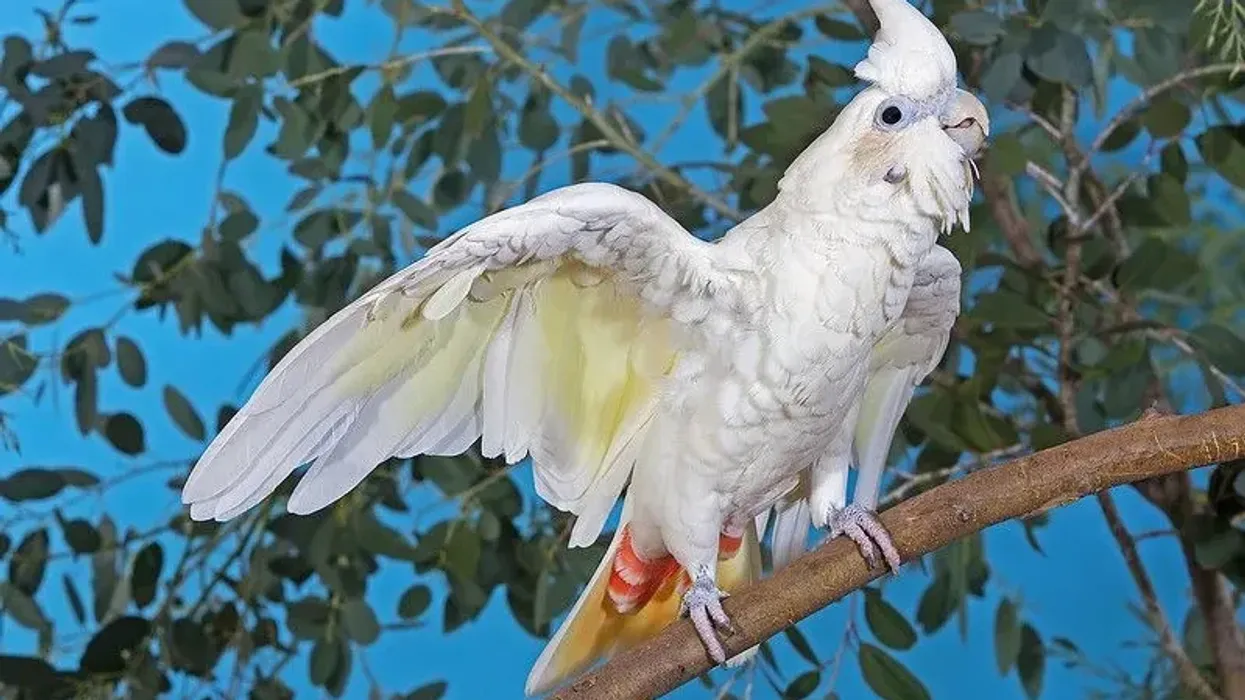The grey-cheeked parakeet (Brotogeris pyrrhoptera) is also known as the fire-winged parakeet because of its orange-flanked underwings. This bird species is endemic to western Ecuador and northwestern Peru.
Habitats of these parrots have been developing in the United States of America. The habitat range of this bird species consists of tropical and sub-tropical areas or regions like dry and lowland, moist forests, arable lands, and shrublands.
The nest of this bird species is made in hollow trees or termite mounds. Around four to six eggs are laid and the incubation is done by both parents for about 25-26 days.
The plumage of this bird species is mostly green in color and as the name suggests, it has gray cheeks and has a gray-bluish crown. The underside of the wings is known to have a bright orange area or orange flank between the coverts and the mantle.
The primary feathers of this bird are known to be bluish or bluish-green. The lores, chin, and cheek-to-ear coverts are pale gray in color.
The bill is known to have an orangish-brown tint. The juveniles are known to look like adults but do not have the bluish wash and the bill of the juveniles is dark brown in color.
Their diet in the wild consists of seeds, fruits, and vegetables, and these birds are fed a pelleted diet along with fresh fruits in captivity. The behavior of this bird is known to be quite active and not considered wild thus, they are known to make great pet birds.
These birds are known to have various behavior gestures and quite expressive body language. These birds have an Endangered status.
It is quite fascinating to learn more about this bird species, the grey-cheeked parakeet (Brotogeris pyrrhoptera) and if you are interested, read our articles on the palm cockatoo and pink cockatoo too.
Grey-Cheeked Parakeet Interesting Facts
What type of animal is a grey-cheeked parakeet?
The grey-cheeked parakeet (Brotogeris pyrrhoptera) or the fire-winged parakeet is a bird.
What class of animal does a grey-cheeked parakeet belong to?
This parakeet belongs to the class of Aves of birds.
How many grey-cheeked parakeets are there in the world?
It is believed that the population of these birds is around 15,000. According to the IUCN Red List, these birds are an Endangered species.
Where does a grey-cheeked parakeet live?
These parrots are endemic to western Ecuador and northwestern Peru. Habitats of these parrots have been developing in the United States of America.
What is a grey-cheeked parakeet's habitat?
The habitat range consists of tropical and sub-tropical areas or regions like dry, lowland, and moist forests, arable lands, and shrublands.
Who do grey-cheeked parakeets live with?
These parakeets can be spotted in small groups or pairs.
How long does a grey-cheeked parakeet live?
These parakeets are known to live for about 23 years on an average in captivity.
How do they reproduce?
These parrots or parakeets are known to mature sexually at about three years of age. They do not build their nest in the canopy of trees, but instead they build their nests in hollow trees or mounds of termites.
Around four to six eggs are laid and the incubation is shared by both the parents for about 25-26 days. After the eggs hatch, the eyes of the chicks or the young ones open in about 12 days.
What is their conservation status?
This species of parrot is known to be placed under the Endangered category of conservation status.
Grey-Cheeked Parakeet Fun Facts
What do grey-cheeked parakeets look like?
The plumage of this bird species is mostly green in color and as the name suggests, it has gray cheeks and a gray-blue crown. The underside of the wings is known to have a bright orange flank between the coverts and the mantle.
The primary feathers of this bird are known to be blue or bluish-green. The lores, chin, and cheek-to-ear coverts are pale gray in color. The bill is known to have an orangish-brown tint.
The eye-ring is bare and white in color and the eyes are dark brown in color. The juveniles are known to look like adults but do not have the blue wash and the bill of the juveniles is dark brown in color.
How cute are they?
These parakeets are considered cute because of their appearance.
How do they communicate?
Just like other bird species, these parrots are known to produce various sounds and calls to communicate.
How big is a grey-cheeked parakeet?
The length of this parrot is around 7.8 in (20 cm). It is smaller than a green parakeet and a sun parakeet.
How fast can a grey-cheeked parakeet fly?
The speed of this parrot is unknown, but its wingspan is around 4.7 in (12 cm).
How much does a grey-cheeked parakeet weigh?
The weight of this bird is around 1.9 oz (54 g).
What are the male and female names of the species?
There are no specific male and female names of this species.
What would you call a baby grey-cheeked parakeet?
While there is no particular name for a baby grey-cheeked parakeet (Brotogeris pyrrhoptera) or the fire-winged parakeet, it is generally referred to as chick, young one, or juvenile.
What do they eat?
The food of this parakeet consists of several fruits, vegetables, and seeds in the wild. They are known to be fed pelleted food or diet and some fresh fruits in captivity.
Are they dangerous?
This species is not considered dangerous.
Would they make a good pet?
Grey-cheeked parakeets or fire-winged parakeets are known to make great pet birds as they are not very large, quite active, and not wild. This bird or pet can be taught to mimic human voices.
Conures should be kept in pairs.
It has been observed that in its native place or range, that is, Ecuador and Peru, these birds or this species of birds are commonly kept as pet birds. However, the population of this birds has been given the status of Endangered so it is best we allow these birds to thrive in the wild.
Did you know...
John Latham described and named the grey-cheeked parakeet in 1801.
The grey-cheeked parakeet (Brotogeris pyrrhoptera) is also known as a fire-winged parakeet because of its orange-flanked underwings.
Grey-cheeked parakeets are known to be less noisy than their cousins who are cockatoos, conures, and macaws.
From the '70s to 1992, several numbers of these birds were imported to the United States. During that time, around the '70s-'90s, these birds were quite popular and were categorized under the 10 most popular birds.
In the United States, grey-cheeked parakeet breeders find it challenging or difficult to breed to this species successfully.
Green-cheeked conures are quite popular for their quiet and calm nature.
What sounds does a grey-cheeked parakeet make?
The calls of a grey-cheeked parakeet (Brotogeris pyrrhoptera) during a flight are known to be repeated trills and the calls are considered to be unsong-like and shrill when perched.
What is the behavior of a grey-cheeked parakeet?
These birds are known to show affection to their owners by being quite clingy. They love to be on someone's shoulders which is why many people choose birds as pets.
Some body language gestures include fluff and ruff, bow and bob, and putting their head down. The grey-cheeked parakeet is known to show how it feels through its crest. For instance, if the crest seems to be back with only the tip sticking or coming out, it means that the bird is relaxed and content.
Here at Kidadl, we have carefully created lots of interesting family-friendly animal facts for everyone to discover! Learn more about some other birds from our Cape May warbler facts and chestnut-sided warbler facts pages.
You can even occupy yourself at home by coloring in one of our free printable parrot mask coloring pages.










